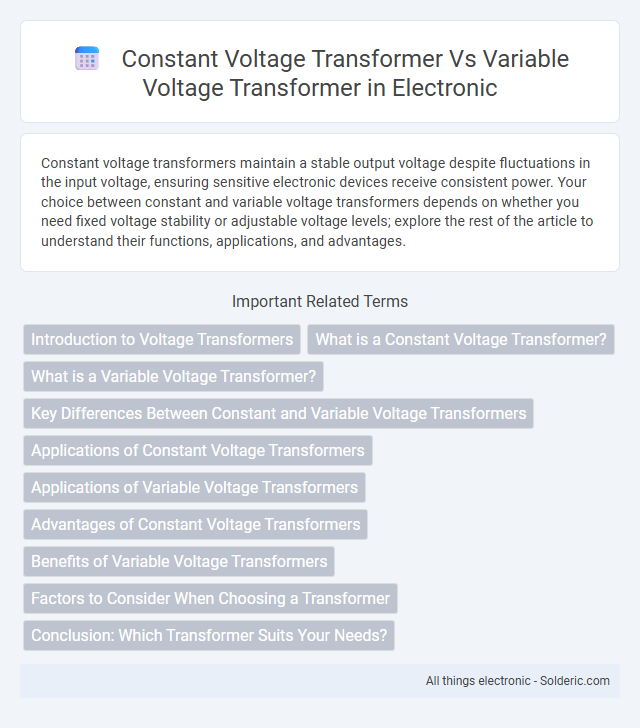Constant voltage transformers maintain a stable output voltage despite fluctuations in the input voltage, ensuring sensitive electronic devices receive consistent power. Your choice between constant and variable voltage transformers depends on whether you need fixed voltage stability or adjustable voltage levels; explore the rest of the article to understand their functions, applications, and advantages.
Comparison Table
| Feature | Constant Voltage Transformer (CVT) | Variable Voltage Transformer (VVT) |
|---|---|---|
| Voltage Regulation | Maintains stable output voltage despite input fluctuations | Provides adjustable output voltage over a range |
| Function | Voltage stabilization and noise filtering | Voltage adjustment and control |
| Output Voltage | Constant, precise voltage | Variable, user-selectable voltage |
| Applications | Power supplies, sensitive electronics, medical devices | Testing labs, voltage control in motors and equipment |
| Design | Series resonant transformer with ferroresonance | Autotransformer with variable tap or rotary winding |
| Efficiency | High efficiency at fixed voltage | Generally efficient but can vary with voltage settings |
| Cost | Higher due to complex design | Lower, simpler construction |
| Output Waveform | Low distortion, constant sine wave | Output waveform depends on tap position; may have slight distortion |
Introduction to Voltage Transformers
Constant voltage transformers (CVTs) and variable voltage transformers (VVTs) serve distinct functions in electrical systems, with CVTs designed to maintain a stable output voltage despite input fluctuations, ensuring consistent power quality. VVTs provide adjustable voltage outputs, allowing precise control over voltage levels for testing, regulation, or equipment calibration. Understanding their operational principles and applications helps optimize performance in power distribution and industrial environments.
What is a Constant Voltage Transformer?
A Constant Voltage Transformer (CVT) provides stable output voltage regardless of input voltage fluctuations, ensuring consistent power quality for sensitive electronic equipment. Unlike a Variable Voltage Transformer (VVT), which allows manual adjustment of output voltage, a CVT automatically maintains voltage within tight limits through magnetic saturation principles. Your devices benefit from enhanced protection against voltage spikes and dips when powered by a CVT, minimizing the risk of damage and operational interruptions.
What is a Variable Voltage Transformer?
A Variable Voltage Transformer (VVT) is an electrical device designed to provide adjustable voltage output by varying the transformer's tap settings or autotransformer winding positions. It enables precise control of voltage levels to match specific load requirements, making it essential in laboratory testing, voltage regulation, and equipment calibration. Unlike Constant Voltage Transformers (CVTs), VVTs offer continuous and flexible voltage variation rather than maintaining a fixed output voltage.
Key Differences Between Constant and Variable Voltage Transformers
Constant voltage transformers provide a stable output voltage regardless of input fluctuations, making them ideal for sensitive electronic equipment, while variable voltage transformers allow adjustable voltage levels for versatile applications like testing and calibration. You benefit from constant voltage transformers when you need reliable, noise-free power, whereas variable voltage transformers offer flexibility in controlling voltage output for different operational requirements. Efficiency and complexity differ as constant voltage transformers use ferroresonant design for stability, whereas variable voltage transformers rely on adjustable winding taps or autotransformer mechanisms.
Applications of Constant Voltage Transformers
Constant voltage transformers (CVTs) are essential in applications requiring stable voltage output despite fluctuating input voltages, such as in sensitive electronic equipment, medical devices, and telecommunications systems. They provide superior voltage regulation and noise isolation, making them ideal for protecting critical loads from voltage sags, surges, and transients. Your equipment benefits from enhanced reliability and longevity when powered through a CVT compared to a variable voltage transformer, which primarily adjusts voltage levels but lacks consistent voltage stabilization.
Applications of Variable Voltage Transformers
Variable voltage transformers are widely used in laboratory testing, voltage regulation, and equipment calibration where precise control of output voltage is essential. They provide adjustable voltage output for testing electrical devices under different voltage conditions, ensuring compatibility and durability. These transformers are critical in research and development environments and in power supply stabilization for sensitive electronic instruments.
Advantages of Constant Voltage Transformers
Constant voltage transformers (CVTs) provide superior voltage regulation by delivering a stable output voltage despite input fluctuations, ensuring consistent power quality for sensitive electronic equipment. They offer high reliability with minimal maintenance due to their robust design and lack of complex electronics or moving parts. CVTs also enhance equipment lifespan and reduce downtime by protecting against voltage spikes, sags, and noise.
Benefits of Variable Voltage Transformers
Variable voltage transformers provide precise voltage control, enhancing the performance of sensitive equipment by delivering adjustable output levels according to specific needs. You benefit from their flexibility in testing and calibration processes, allowing for simulation of voltage variations and ensuring reliable operation under different conditions. These transformers also improve energy efficiency by optimizing voltage supply, reducing energy waste compared to constant voltage transformers.
Factors to Consider When Choosing a Transformer
When choosing between a constant voltage transformer (CVT) and a variable voltage transformer (VVT), consider the voltage regulation requirements and load stability of your application. A CVT provides consistent voltage output despite input fluctuations, ideal for sensitive electronic equipment, while a VVT allows adjustable voltage levels, suitable for testing or applications needing variable supply. Your decision should also factor in efficiency, size, cost, and the specific voltage range compatibility with your devices.
Conclusion: Which Transformer Suits Your Needs?
Constant voltage transformers (CVTs) provide stable output voltage despite input fluctuations, making them ideal for sensitive electronics and precision equipment requiring consistent power. Variable voltage transformers (VVTs) offer adjustable output voltage, suitable for testing, calibration, and applications needing controlled voltage variation. Selecting between CVT and VVT depends on whether your priority is maintaining steady voltage or requiring variable, adjustable voltage for specific operational conditions.
constant voltage transformer vs variable voltage transformer Infographic

 solderic.com
solderic.com